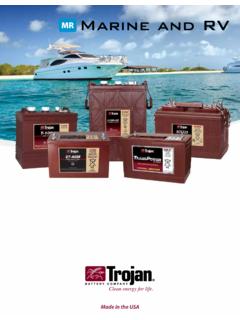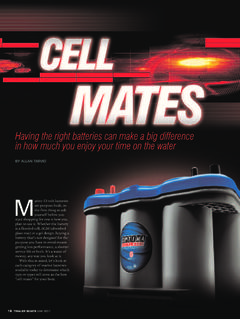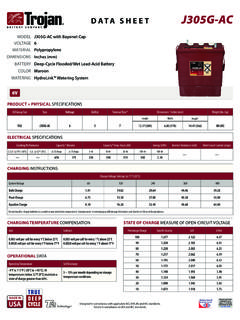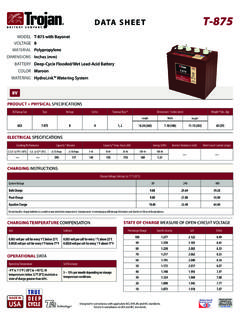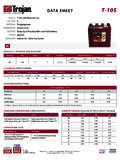Transcription of Effects of Impurities on Lead-Acid Batteries - …
1 Table 1 Recommended Maximum Allowable Impurities in Water for Battery UseImpurityParts Per MillionEffects of ImpurityColorClear and White -Suspended MatterTrace-Total and Volatile of positive self -discharge of both by local action, reduces life, lowers on-charge , can form poisonous gas at positive of capacity in both plates, greater loss in self-discharge, lowers on-charge self-discharge at both plates, lowers on charge lifeNickelNone AllowedIntense lowering of on-charge sulfation at at both plates, loss of capacity, reduced lifePlatinumNone AllowedViolent self-discharge, lowers on-charge self-discharge at negativeIntroductionIn Lead-Acid Batteries , water purity can have a major effect on product performance. Water usage needs to be viewed as a priority for maximum performance.
2 The popular misconception is that any type of water can be used. Natural waters may vary considerably in the amount of Impurities they contain. Some factors include the source of the water and the time of year. Throughout the country there are various water sources with different amounts of Impurities . Contaminates in the water source play a large part in the performance and life of a of WaterThe most common type of water used in Batteries is distilled water. Other types are deionized water and water from reverse osmosis. Ordinary tap water should not be used because it may contain an excessive amount of Impurities that will degrade battery performance. (See Table 1 for acceptable maximum allowable Impurities in water for battery use). Distilled water is produced by distillation, a process in which water is boiled, the steam is collected and then condensed back into water.
3 This process creates a finished product free of minerals, having left all the Impurities in the original water water is the purest form of water, but it is also the most expensive. The process of deionization removes all ionizable particles (organic and inorganic) from water through ion exchange. Positively and negatively charged ions are removed from the water and replaced with H+ and OH- ions. When these two ions are combined, they form H2O or purified water. Reverse osmosis is a method of removing solids from water by forcing it through a membrane. The membrane rejects all solids while allowing purified water to pass through. The choice of membrane determines the amount of Impurities that the water may Allowable AmountsWhen discussing water purity, one must consider the amount of dissolved solid contaminates in the solution.
4 The issue then is the maximum allowable amount of Impurities that water may contain and still be suitable for battery use. The parts-per-million count has been developed to address this issue. Battery literature suggests a parts-per-million count not in excess of 100. Table 1 shows a list of maximum allowable Impurities in on the BatteryThe mineral content may be minimal in some water. The gassing Effects from charging a storage battery, coupled with evaporation, may leave behind mineral contaminates in the electrolyte solution. As a result, the minerals will have a cumulative effect inside the battery. Table 1 shows the Effects of the different Impurities . Page 1 WHITE PAPERE ffects of Impurities on Lead-Acid + 2019 Trojan Battery Company, LLC. All rights reserved.
5 Trojan Battery Company is not liable for damages that may result from any information provided in or omitted from this publication, under any circumstances. Trojan Battery Company reserves the right to make adjustments to this publication at any time, without notice or check the Trojan Battery website ( ) for the most up-to-date SLUSHER DRIVE, SANTA FE SPRINGS, CA 90670WP_EffectOfImpurities_010419 Depending on the type of impurity, the physical characteristics as well as the performance of the battery may be affected. The Impurities may hinder both the positive and negative plates. Impurities may also cause a variety of reactions in the battery, hence different behavioral characteristics. Some Impurities have an effect on the metallic components only, and some affect the separators.
6 Either scenario will lead to a drop in performance. An increase in self-discharge at either plate is the most common effect . This will deplete the battery s capacity at an increased rate. Impurities that increase self-discharge characteristics typically have an effect on cycle life and charge voltage. The cycle life is reduced and the on-charge voltage is lowered. Ultimately, the overall rated performance of the battery will be conclusion, for the best overall performance from the battery, distilled water is the most beneficial type of water to use. It is also important to have the water filled to the proper levels. For standard Batteries , electrolyte levels should be 1/8 below the bottom of the vent well about 1/2 to 3/4 above the top of the plates. For Plus Series Batteries , add water to the maximum water level indicator.
7 The electrolyte should not be allowed to drop below the top of the plates. Only, distilled, deionized or approved water should be added to achieve the recommended levels mentioned above. acid SHOULD NEVER BE ADDED TO THE maintenance of a Lead-Acid battery will help to assure peak performance and full use of the battery s designed 2800-423-6569 Ext. 3045 / SUPPORT

